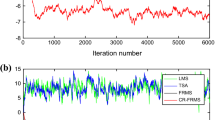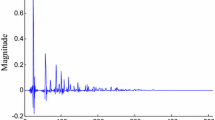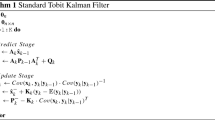Abstract
The censored observations of adaptive signal processing have widely occurred in plenty of utility applications. Using traditional adaptive algorithms to recognize systems will confront convergence reduced under these circumstances. To address the above problem, the least mean square algorithm for censored regression (CR-LMS) has been proposed. However, the CR-LMS algorithm will converge slowly under colored inputs. In this paper, a pseudo affine projection algorithm based on censored regression (CR-PAP) is present to process colored input signals. Moreover, the variable step-size strategy is used to enhance the convergence performance. Computer simulations verify the better convergence of the proposed algorithm over the CR-LMS algorithm in system identification scenarios.



Similar content being viewed by others
Availability of data and materials
The datasets generated during and/or analyzed during the current study are available from the first author on reasonable request.
References
Lee, K.A., Gan, W.S., Kuo, S.M.: Subband adaptive filtering: theory and implementation. Wiley, New York (2009)
Bhotto, M.Z.A., Ahmad, M.O., Swamy, M.N.S.: Robust shrinkage affine-projection sign adaptive-filtering algorithms for impulsive noise environments. IEEE Trans. Signal Process. 62(13), 3349–3359 (2014)
Widrow, B., Sterns, S.D.: Adaptive signal processing. Prentice-Hall, Englewood Cliffs (1985)
Zhang, S., Zhang, J.: Enhancing the tracking capability of recursive least p-norm algorithm via adaptive gain factor. Digital Signal Process. 30, 67–73 (2014)
Wen, P., Zhang, J.: A novel variable step-size normalized subband adaptive filter based on mixed error cost function. Signal Process. 138, 48–52 (2017)
Powell, J.L.: Least absolute deviations estimation for the censored regression model. J. Economet. 25(3), 303–325 (1984)
Cook, J., McDonald, J.: Partially adaptive estimation of interval censored regression models. Comput. Econ. 42(1), 119–131 (2013)
Heckman, J. J.: The common structure of statistical models of truncation, sample selection and limited dependent variables. Ann. Econ. Social Meas. 5(4), 311–801, 475492, (1976).
Liu, Z., Li, C., Liu, Y.: Distributed censored regression over networks. IEEE Trans. Signal Process. 63(20), 5437–5449 (2015)
Liu, Z., Li, C.: Recursive least squares for censored regression. IEEE Trans. Signal Process. 65(6), 1565–1579 (2017)
Wang, G., Zhao, H.: Robust adaptive least mean M-estimate algorithm for censored regression. In: IEEE Transactions on Systems, Man, and Cybernetics: Systems, (2021).
Wen, P., Zhang, J., Zhang S, et al.: Normalized subband spline adaptive filter: Algorithm derivation and analysis. Circuits Syst. Signal Process. 40(5), 2400–2418 (2021)
Huang, F., Zhang, J., Zhang, S.: Affine projection versoria algorithm for robust adaptive echo cancellation in hands-free voice communications. IEEE Trans. Vehicular Technol. 67(12), 11924–11935 (2018)
Zhao, H., Zhao, F., Wang, G. et al.: Affine projection algorithm for censored regression. IEEE Trans. Circuits Syst. II: Express Briefs, 68(12),3602–3606 (2001).
Ban, S.J., Lee, C.W., Kim, S.W.: Adaptive regularization parameter for pseudo affine projection algorithm. IEEE Signal Process. Lett. 16(5), 382–385 (2009)
Zhao, F., Zhao, H., Wang, W.: A robust M-shaped error weighted algorithms for censored regression. Circuits Syst Signal Process. 39(1), 324–343 (2020)
Huang, F., Zhang, J., Zhang, S., et al.: Diffusion Bayesian subband adaptive filters for distributed estimation over sensor networks. IEEE Trans. Commun. 69(10), 6909–6925 (2021)
Zhang, S., Zhang, J., Xia, Y., et al.: Adaptive frequency-domain normalized implementations of widely-linear complex-valued filter. IEEE Trans. on Signal Processing 69, 5801–5814 (2021)
McDonald, J.F., Moffitt, R. A.: The uses of Tobit analysis. In: The Review of Economics and Statistics, pp. 318–321 (1980)
Peng, Y., Zhang, S., Zhou, Z. et al.: Full mean-square analysis of affine combination of two complex-valued LMS filters for second-order non-circular inputs. IEEE Signal Process. Lett. 29, 1157–1161 (2022).
Wen, P., Zhang, S., Du, S., et al.: A full mean-square analysis of CNSAF algorithm for noncircular inputs. J. Franklin Inst. 358(15), 7883–7899 (2021)
Yu, Y., Zhao, H.: Performance analysis of the deficient length NSAF algorithm and a variable step-size method for improving its performance. Digital Signal Process. 62, 157–167 (2017)
Kwong, R.H., Johnston, E.W.: A variable step size LMS algorithm. IEEE Trans. Signal Process. 40(7), 1633–1642 (1992)
Acknowledgements
This work was partially supported by the National Science Foundation of P.R. China under 62001528 and 61976237, Key Teacher Program of Zhongyuan University of Technology (2021XQG08), National Science Foundation of Zhongyuan University of Technology (K2023MS016), Young Master of Discipline Incubation Program of Zhongyuan University of Technology (SD202206 and SD202209), Science and Technology Innovation Team of Colleges and Universities in Henan Province (22IRTSTHN015), the Research Award Fund for Outstanding Yong Teachers in Colleges and Universities of Henan Province (2020GGJS141).
Funding
Not applicate.
Author information
Authors and Affiliations
Contributions
BW and PW wrote the main manuscript text. Other authors checked the language of the article.
Corresponding author
Ethics declarations
Conflict of interest
The authors declare that they have no known competing financial interests or personal relationships that could have appeared to influence the work reported in this paper.
Ethical approval
Not applicate.
Additional information
Publisher's Note
Springer Nature remains neutral with regard to jurisdictional claims in published maps and institutional affiliations.
Appendix
Appendix
The conditional density function of the cumulative distribution function of the random variable \(x\), which satisfies the formula in Table
2, can be written as follows:
where \(f(x)\) and \(F(x)\) are given in Table 2. According to the probability theoretical calculated the conditional expectation, the \(E[x|x > a]\) can be expressed as follows:
Rights and permissions
Springer Nature or its licensor (e.g. a society or other partner) holds exclusive rights to this article under a publishing agreement with the author(s) or other rightsholder(s); author self-archiving of the accepted manuscript version of this article is solely governed by the terms of such publishing agreement and applicable law.
About this article
Cite this article
Wang, B., Wen, P., Qu, B. et al. Variable step-size pseudo affine projection algorithm for censored regression. SIViP 17, 4229–4234 (2023). https://doi.org/10.1007/s11760-023-02655-3
Received:
Revised:
Accepted:
Published:
Issue Date:
DOI: https://doi.org/10.1007/s11760-023-02655-3




